Health Workforce Planning Report: Comparing Australia and Singapore
VerifiedAdded on 2021/05/30
|18
|4163
|70
Report
AI Summary
This report undertakes a comparative analysis of health workforce planning in Australia and Singapore. It begins with executive summaries, then proceeds to an in-depth environmental scan of the healthcare workforces in both countries, examining the influence of internal and external factors, including economic conditions, government policies, and the composition of the workforce. The report delves into data profiles of the health workforce, drawing on WHO statistics to identify critical factors such as the number of physicians, nurses, and other healthcare personnel. It also highlights the economic factors affecting the workforce, such as the ability to retain workers in the public sector. Furthermore, the study incorporates the WHO's ten recommendations for workforce development, offering insights into how Australia and Singapore are adhering to these guidelines. The report aims to provide a comprehensive overview of health workforce planning, identifying strengths, weaknesses, and areas for improvement in both countries.
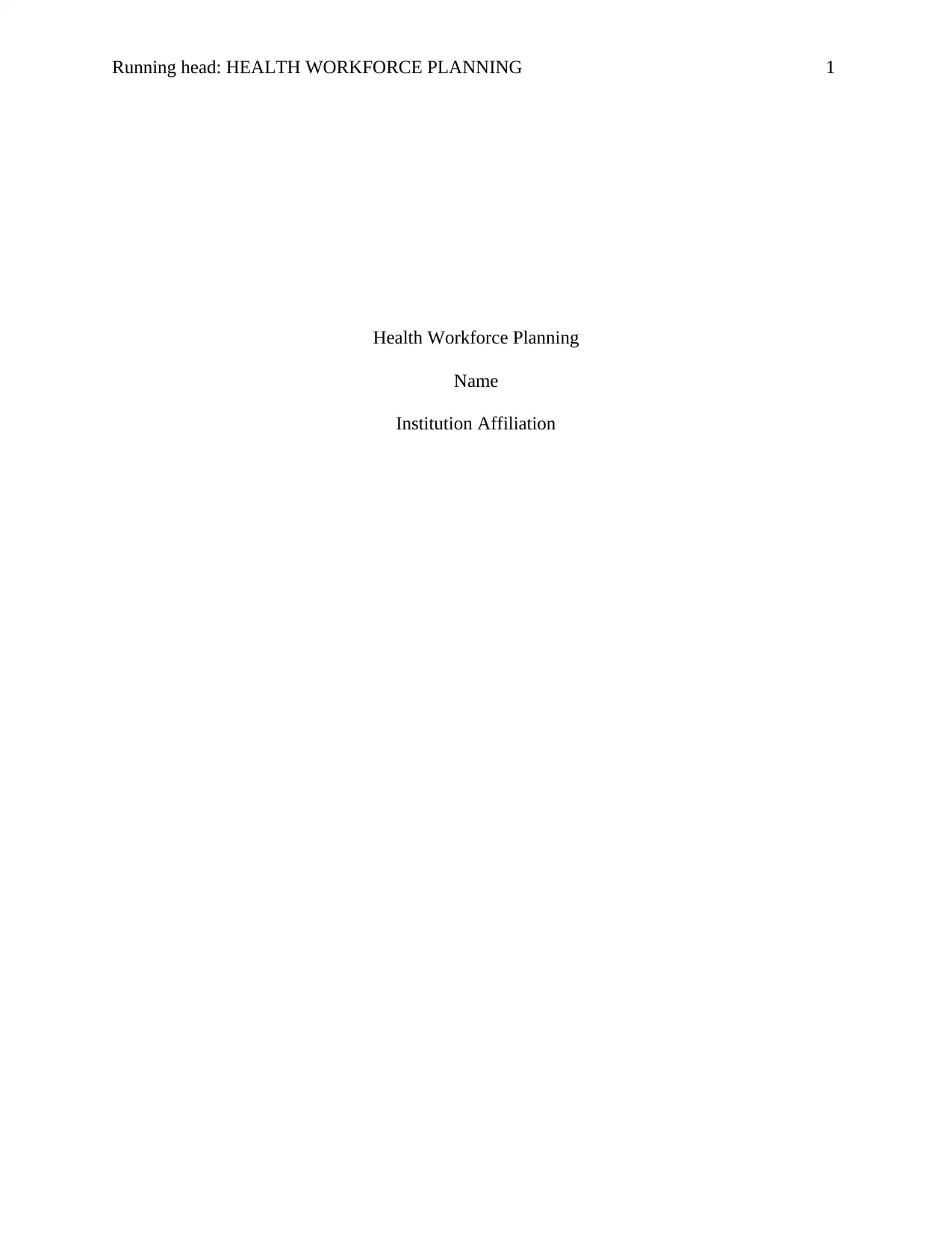
Running head: HEALTH WORKFORCE PLANNING 1
Health Workforce Planning
Name
Institution Affiliation
Health Workforce Planning
Name
Institution Affiliation
Paraphrase This Document
Need a fresh take? Get an instant paraphrase of this document with our AI Paraphraser
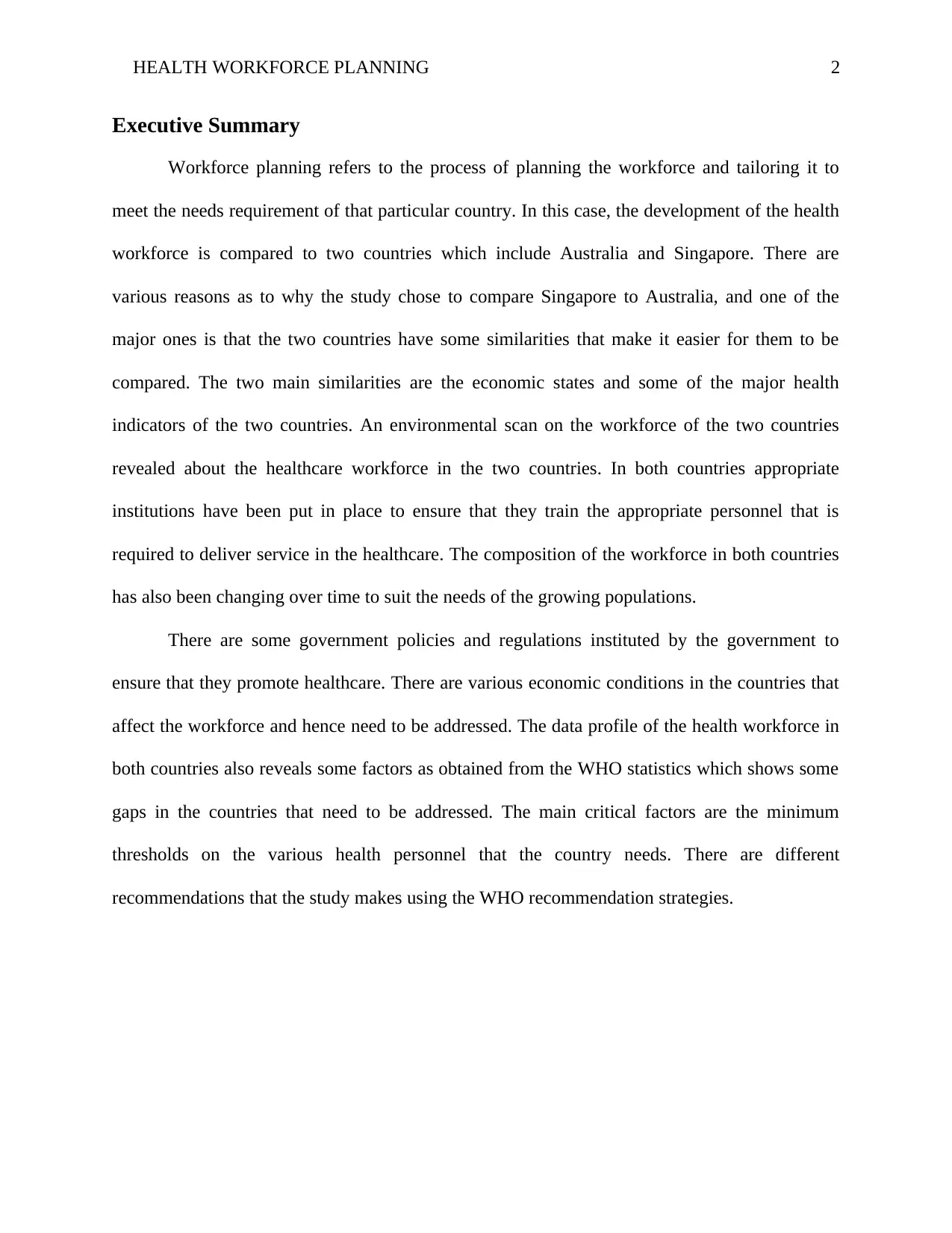
HEALTH WORKFORCE PLANNING 2
Executive Summary
Workforce planning refers to the process of planning the workforce and tailoring it to
meet the needs requirement of that particular country. In this case, the development of the health
workforce is compared to two countries which include Australia and Singapore. There are
various reasons as to why the study chose to compare Singapore to Australia, and one of the
major ones is that the two countries have some similarities that make it easier for them to be
compared. The two main similarities are the economic states and some of the major health
indicators of the two countries. An environmental scan on the workforce of the two countries
revealed about the healthcare workforce in the two countries. In both countries appropriate
institutions have been put in place to ensure that they train the appropriate personnel that is
required to deliver service in the healthcare. The composition of the workforce in both countries
has also been changing over time to suit the needs of the growing populations.
There are some government policies and regulations instituted by the government to
ensure that they promote healthcare. There are various economic conditions in the countries that
affect the workforce and hence need to be addressed. The data profile of the health workforce in
both countries also reveals some factors as obtained from the WHO statistics which shows some
gaps in the countries that need to be addressed. The main critical factors are the minimum
thresholds on the various health personnel that the country needs. There are different
recommendations that the study makes using the WHO recommendation strategies.
Executive Summary
Workforce planning refers to the process of planning the workforce and tailoring it to
meet the needs requirement of that particular country. In this case, the development of the health
workforce is compared to two countries which include Australia and Singapore. There are
various reasons as to why the study chose to compare Singapore to Australia, and one of the
major ones is that the two countries have some similarities that make it easier for them to be
compared. The two main similarities are the economic states and some of the major health
indicators of the two countries. An environmental scan on the workforce of the two countries
revealed about the healthcare workforce in the two countries. In both countries appropriate
institutions have been put in place to ensure that they train the appropriate personnel that is
required to deliver service in the healthcare. The composition of the workforce in both countries
has also been changing over time to suit the needs of the growing populations.
There are some government policies and regulations instituted by the government to
ensure that they promote healthcare. There are various economic conditions in the countries that
affect the workforce and hence need to be addressed. The data profile of the health workforce in
both countries also reveals some factors as obtained from the WHO statistics which shows some
gaps in the countries that need to be addressed. The main critical factors are the minimum
thresholds on the various health personnel that the country needs. There are different
recommendations that the study makes using the WHO recommendation strategies.
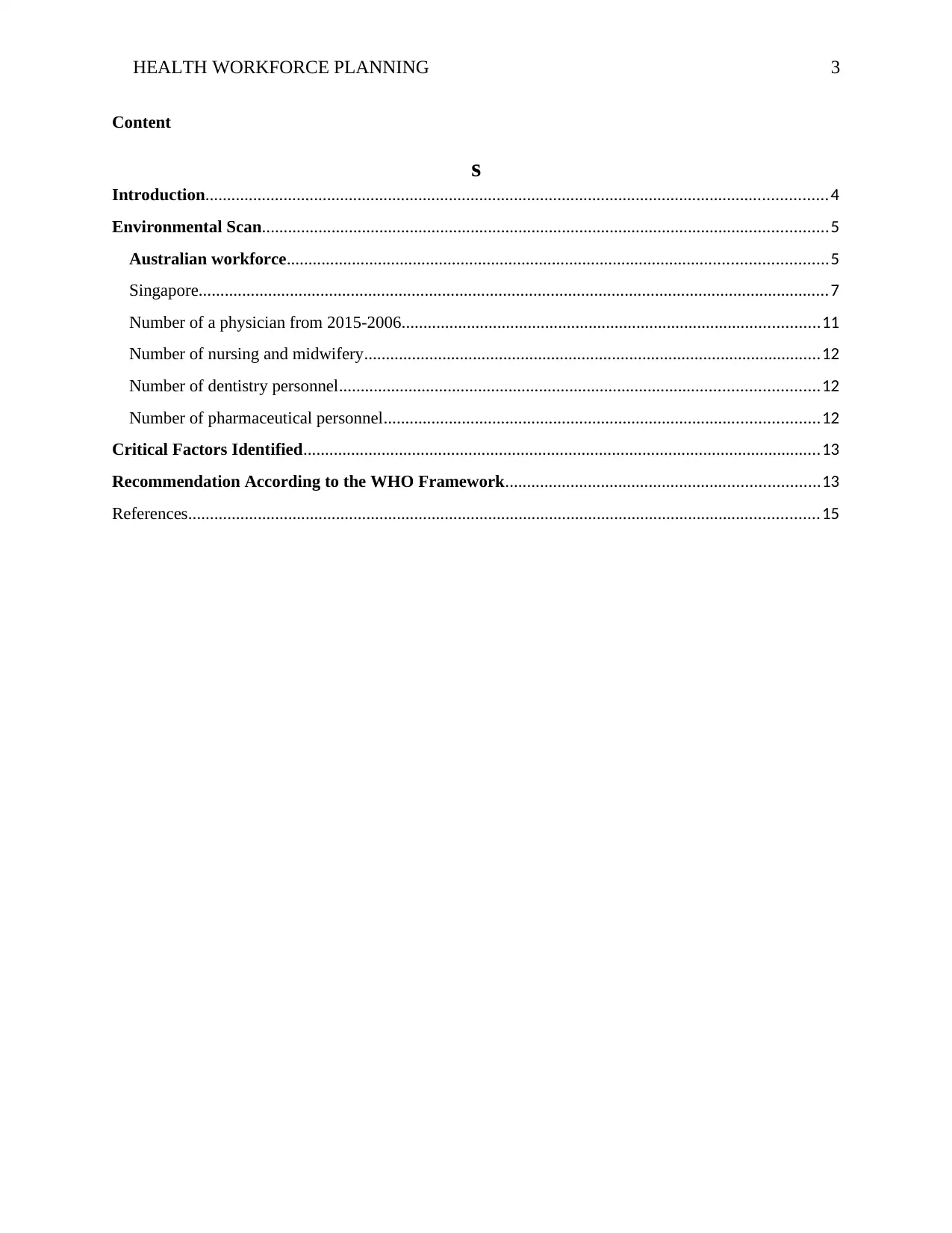
HEALTH WORKFORCE PLANNING 3
Content
s
Introduction...............................................................................................................................................4
Environmental Scan..................................................................................................................................5
Australian workforce............................................................................................................................5
Singapore.................................................................................................................................................7
Number of a physician from 2015-2006................................................................................................11
Number of nursing and midwifery.........................................................................................................12
Number of dentistry personnel..............................................................................................................12
Number of pharmaceutical personnel....................................................................................................12
Critical Factors Identified.......................................................................................................................13
Recommendation According to the WHO Framework........................................................................13
References.................................................................................................................................................15
Content
s
Introduction...............................................................................................................................................4
Environmental Scan..................................................................................................................................5
Australian workforce............................................................................................................................5
Singapore.................................................................................................................................................7
Number of a physician from 2015-2006................................................................................................11
Number of nursing and midwifery.........................................................................................................12
Number of dentistry personnel..............................................................................................................12
Number of pharmaceutical personnel....................................................................................................12
Critical Factors Identified.......................................................................................................................13
Recommendation According to the WHO Framework........................................................................13
References.................................................................................................................................................15
⊘ This is a preview!⊘
Do you want full access?
Subscribe today to unlock all pages.

Trusted by 1+ million students worldwide
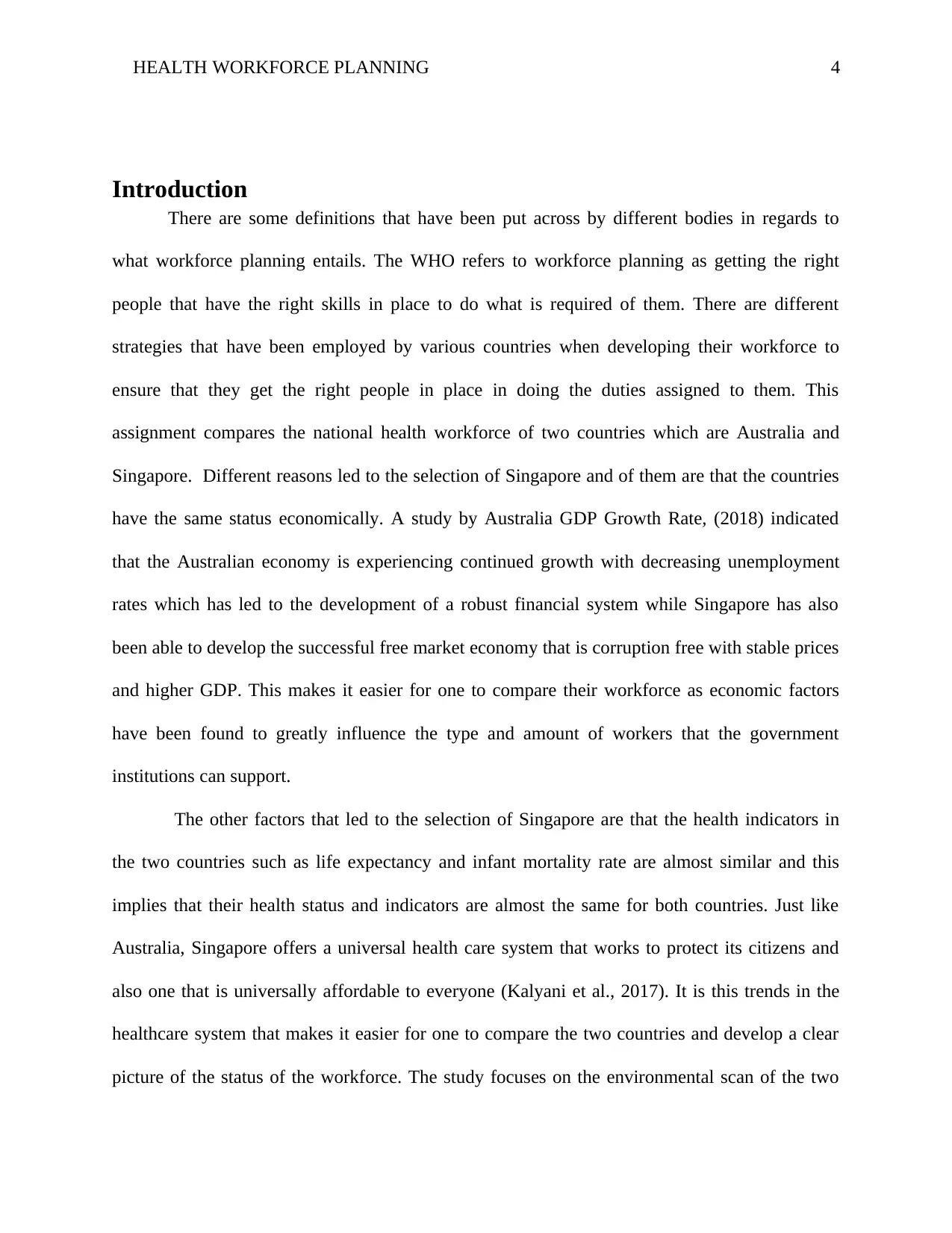
HEALTH WORKFORCE PLANNING 4
Introduction
There are some definitions that have been put across by different bodies in regards to
what workforce planning entails. The WHO refers to workforce planning as getting the right
people that have the right skills in place to do what is required of them. There are different
strategies that have been employed by various countries when developing their workforce to
ensure that they get the right people in place in doing the duties assigned to them. This
assignment compares the national health workforce of two countries which are Australia and
Singapore. Different reasons led to the selection of Singapore and of them are that the countries
have the same status economically. A study by Australia GDP Growth Rate, (2018) indicated
that the Australian economy is experiencing continued growth with decreasing unemployment
rates which has led to the development of a robust financial system while Singapore has also
been able to develop the successful free market economy that is corruption free with stable prices
and higher GDP. This makes it easier for one to compare their workforce as economic factors
have been found to greatly influence the type and amount of workers that the government
institutions can support.
The other factors that led to the selection of Singapore are that the health indicators in
the two countries such as life expectancy and infant mortality rate are almost similar and this
implies that their health status and indicators are almost the same for both countries. Just like
Australia, Singapore offers a universal health care system that works to protect its citizens and
also one that is universally affordable to everyone (Kalyani et al., 2017). It is this trends in the
healthcare system that makes it easier for one to compare the two countries and develop a clear
picture of the status of the workforce. The study focuses on the environmental scan of the two
Introduction
There are some definitions that have been put across by different bodies in regards to
what workforce planning entails. The WHO refers to workforce planning as getting the right
people that have the right skills in place to do what is required of them. There are different
strategies that have been employed by various countries when developing their workforce to
ensure that they get the right people in place in doing the duties assigned to them. This
assignment compares the national health workforce of two countries which are Australia and
Singapore. Different reasons led to the selection of Singapore and of them are that the countries
have the same status economically. A study by Australia GDP Growth Rate, (2018) indicated
that the Australian economy is experiencing continued growth with decreasing unemployment
rates which has led to the development of a robust financial system while Singapore has also
been able to develop the successful free market economy that is corruption free with stable prices
and higher GDP. This makes it easier for one to compare their workforce as economic factors
have been found to greatly influence the type and amount of workers that the government
institutions can support.
The other factors that led to the selection of Singapore are that the health indicators in
the two countries such as life expectancy and infant mortality rate are almost similar and this
implies that their health status and indicators are almost the same for both countries. Just like
Australia, Singapore offers a universal health care system that works to protect its citizens and
also one that is universally affordable to everyone (Kalyani et al., 2017). It is this trends in the
healthcare system that makes it easier for one to compare the two countries and develop a clear
picture of the status of the workforce. The study focuses on the environmental scan of the two
Paraphrase This Document
Need a fresh take? Get an instant paraphrase of this document with our AI Paraphraser
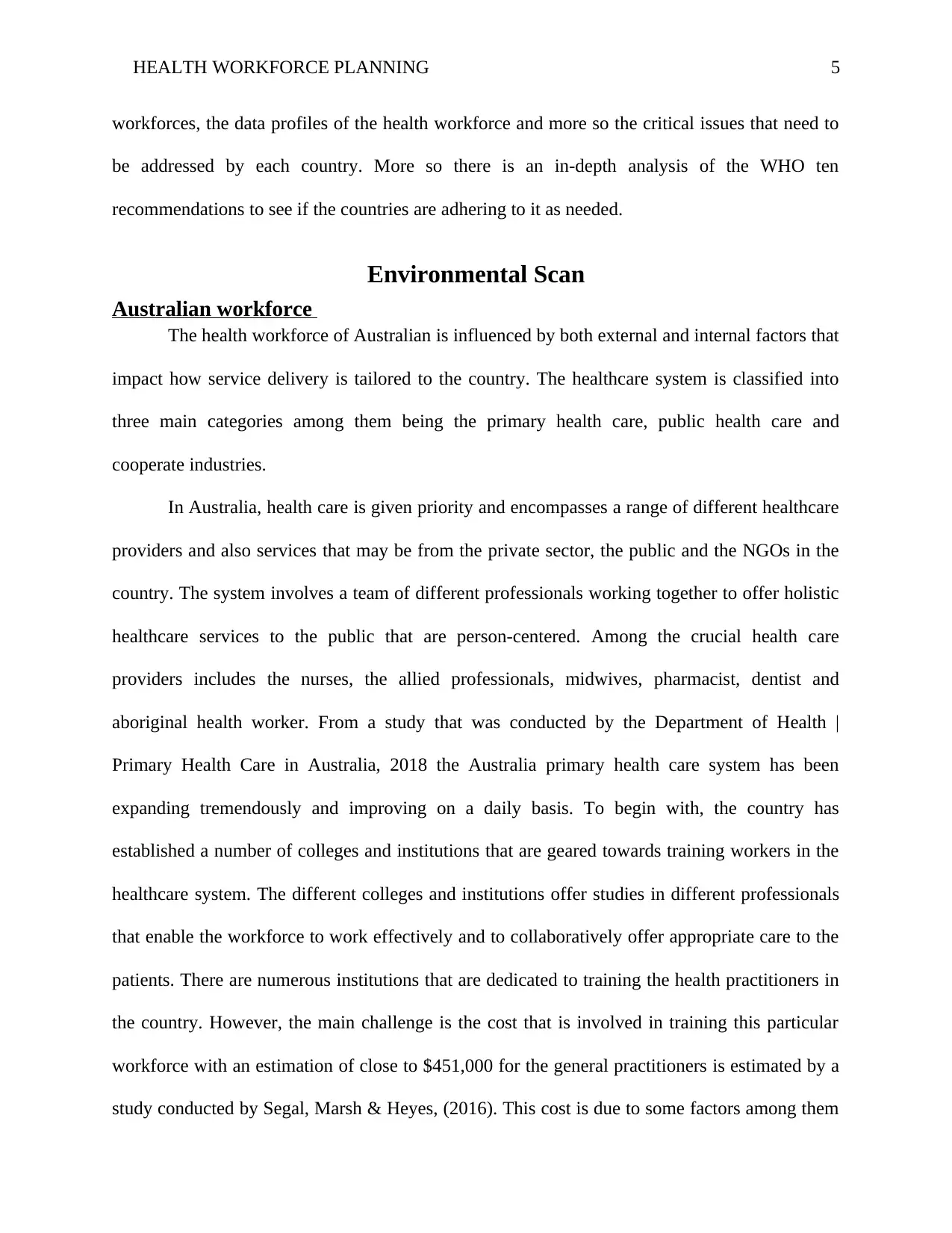
HEALTH WORKFORCE PLANNING 5
workforces, the data profiles of the health workforce and more so the critical issues that need to
be addressed by each country. More so there is an in-depth analysis of the WHO ten
recommendations to see if the countries are adhering to it as needed.
Environmental Scan
Australian workforce
The health workforce of Australian is influenced by both external and internal factors that
impact how service delivery is tailored to the country. The healthcare system is classified into
three main categories among them being the primary health care, public health care and
cooperate industries.
In Australia, health care is given priority and encompasses a range of different healthcare
providers and also services that may be from the private sector, the public and the NGOs in the
country. The system involves a team of different professionals working together to offer holistic
healthcare services to the public that are person-centered. Among the crucial health care
providers includes the nurses, the allied professionals, midwives, pharmacist, dentist and
aboriginal health worker. From a study that was conducted by the Department of Health |
Primary Health Care in Australia, 2018 the Australia primary health care system has been
expanding tremendously and improving on a daily basis. To begin with, the country has
established a number of colleges and institutions that are geared towards training workers in the
healthcare system. The different colleges and institutions offer studies in different professionals
that enable the workforce to work effectively and to collaboratively offer appropriate care to the
patients. There are numerous institutions that are dedicated to training the health practitioners in
the country. However, the main challenge is the cost that is involved in training this particular
workforce with an estimation of close to $451,000 for the general practitioners is estimated by a
study conducted by Segal, Marsh & Heyes, (2016). This cost is due to some factors among them
workforces, the data profiles of the health workforce and more so the critical issues that need to
be addressed by each country. More so there is an in-depth analysis of the WHO ten
recommendations to see if the countries are adhering to it as needed.
Environmental Scan
Australian workforce
The health workforce of Australian is influenced by both external and internal factors that
impact how service delivery is tailored to the country. The healthcare system is classified into
three main categories among them being the primary health care, public health care and
cooperate industries.
In Australia, health care is given priority and encompasses a range of different healthcare
providers and also services that may be from the private sector, the public and the NGOs in the
country. The system involves a team of different professionals working together to offer holistic
healthcare services to the public that are person-centered. Among the crucial health care
providers includes the nurses, the allied professionals, midwives, pharmacist, dentist and
aboriginal health worker. From a study that was conducted by the Department of Health |
Primary Health Care in Australia, 2018 the Australia primary health care system has been
expanding tremendously and improving on a daily basis. To begin with, the country has
established a number of colleges and institutions that are geared towards training workers in the
healthcare system. The different colleges and institutions offer studies in different professionals
that enable the workforce to work effectively and to collaboratively offer appropriate care to the
patients. There are numerous institutions that are dedicated to training the health practitioners in
the country. However, the main challenge is the cost that is involved in training this particular
workforce with an estimation of close to $451,000 for the general practitioners is estimated by a
study conducted by Segal, Marsh & Heyes, (2016). This cost is due to some factors among them
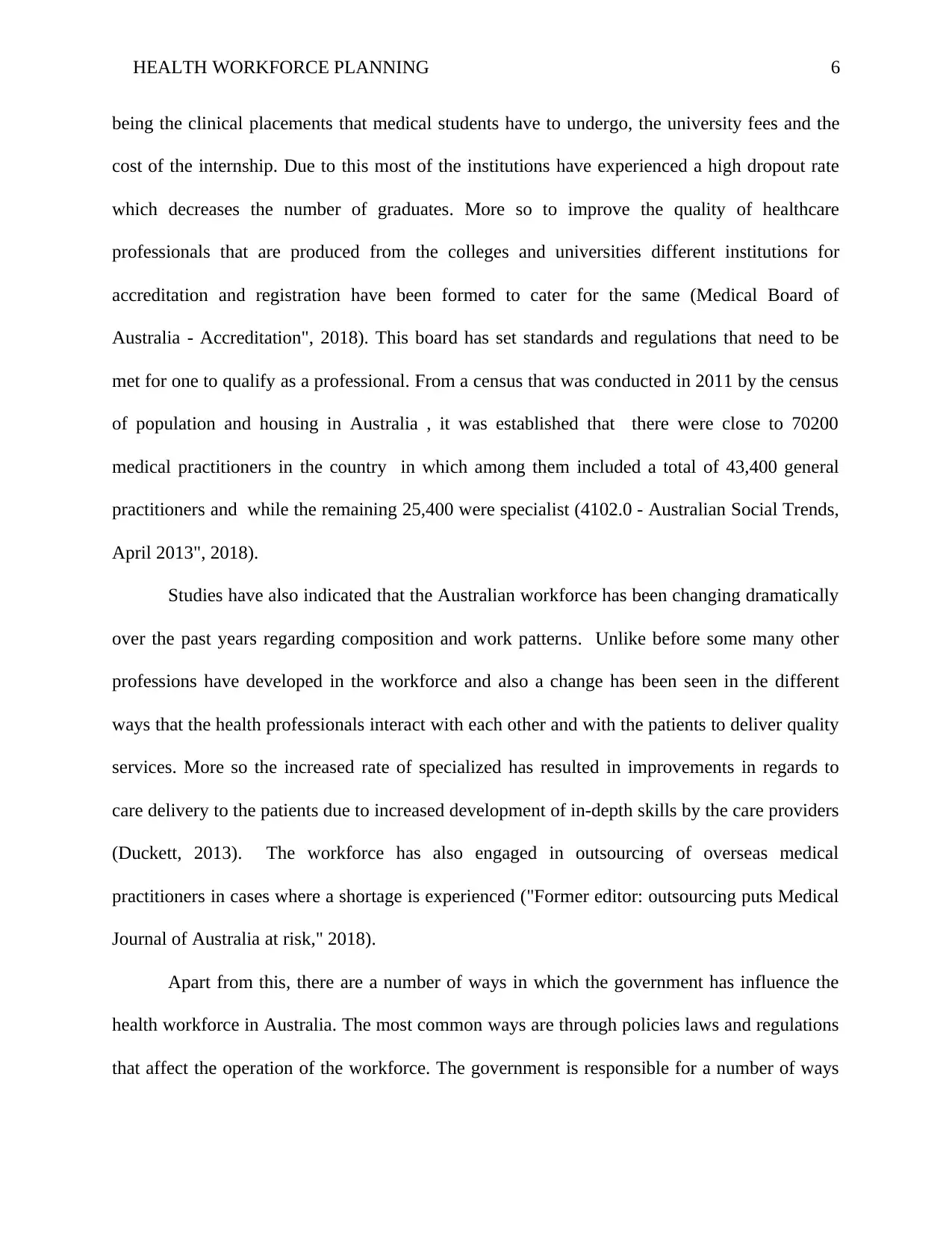
HEALTH WORKFORCE PLANNING 6
being the clinical placements that medical students have to undergo, the university fees and the
cost of the internship. Due to this most of the institutions have experienced a high dropout rate
which decreases the number of graduates. More so to improve the quality of healthcare
professionals that are produced from the colleges and universities different institutions for
accreditation and registration have been formed to cater for the same (Medical Board of
Australia - Accreditation", 2018). This board has set standards and regulations that need to be
met for one to qualify as a professional. From a census that was conducted in 2011 by the census
of population and housing in Australia , it was established that there were close to 70200
medical practitioners in the country in which among them included a total of 43,400 general
practitioners and while the remaining 25,400 were specialist (4102.0 - Australian Social Trends,
April 2013", 2018).
Studies have also indicated that the Australian workforce has been changing dramatically
over the past years regarding composition and work patterns. Unlike before some many other
professions have developed in the workforce and also a change has been seen in the different
ways that the health professionals interact with each other and with the patients to deliver quality
services. More so the increased rate of specialized has resulted in improvements in regards to
care delivery to the patients due to increased development of in-depth skills by the care providers
(Duckett, 2013). The workforce has also engaged in outsourcing of overseas medical
practitioners in cases where a shortage is experienced ("Former editor: outsourcing puts Medical
Journal of Australia at risk," 2018).
Apart from this, there are a number of ways in which the government has influence the
health workforce in Australia. The most common ways are through policies laws and regulations
that affect the operation of the workforce. The government is responsible for a number of ways
being the clinical placements that medical students have to undergo, the university fees and the
cost of the internship. Due to this most of the institutions have experienced a high dropout rate
which decreases the number of graduates. More so to improve the quality of healthcare
professionals that are produced from the colleges and universities different institutions for
accreditation and registration have been formed to cater for the same (Medical Board of
Australia - Accreditation", 2018). This board has set standards and regulations that need to be
met for one to qualify as a professional. From a census that was conducted in 2011 by the census
of population and housing in Australia , it was established that there were close to 70200
medical practitioners in the country in which among them included a total of 43,400 general
practitioners and while the remaining 25,400 were specialist (4102.0 - Australian Social Trends,
April 2013", 2018).
Studies have also indicated that the Australian workforce has been changing dramatically
over the past years regarding composition and work patterns. Unlike before some many other
professions have developed in the workforce and also a change has been seen in the different
ways that the health professionals interact with each other and with the patients to deliver quality
services. More so the increased rate of specialized has resulted in improvements in regards to
care delivery to the patients due to increased development of in-depth skills by the care providers
(Duckett, 2013). The workforce has also engaged in outsourcing of overseas medical
practitioners in cases where a shortage is experienced ("Former editor: outsourcing puts Medical
Journal of Australia at risk," 2018).
Apart from this, there are a number of ways in which the government has influence the
health workforce in Australia. The most common ways are through policies laws and regulations
that affect the operation of the workforce. The government is responsible for a number of ways
⊘ This is a preview!⊘
Do you want full access?
Subscribe today to unlock all pages.

Trusted by 1+ million students worldwide
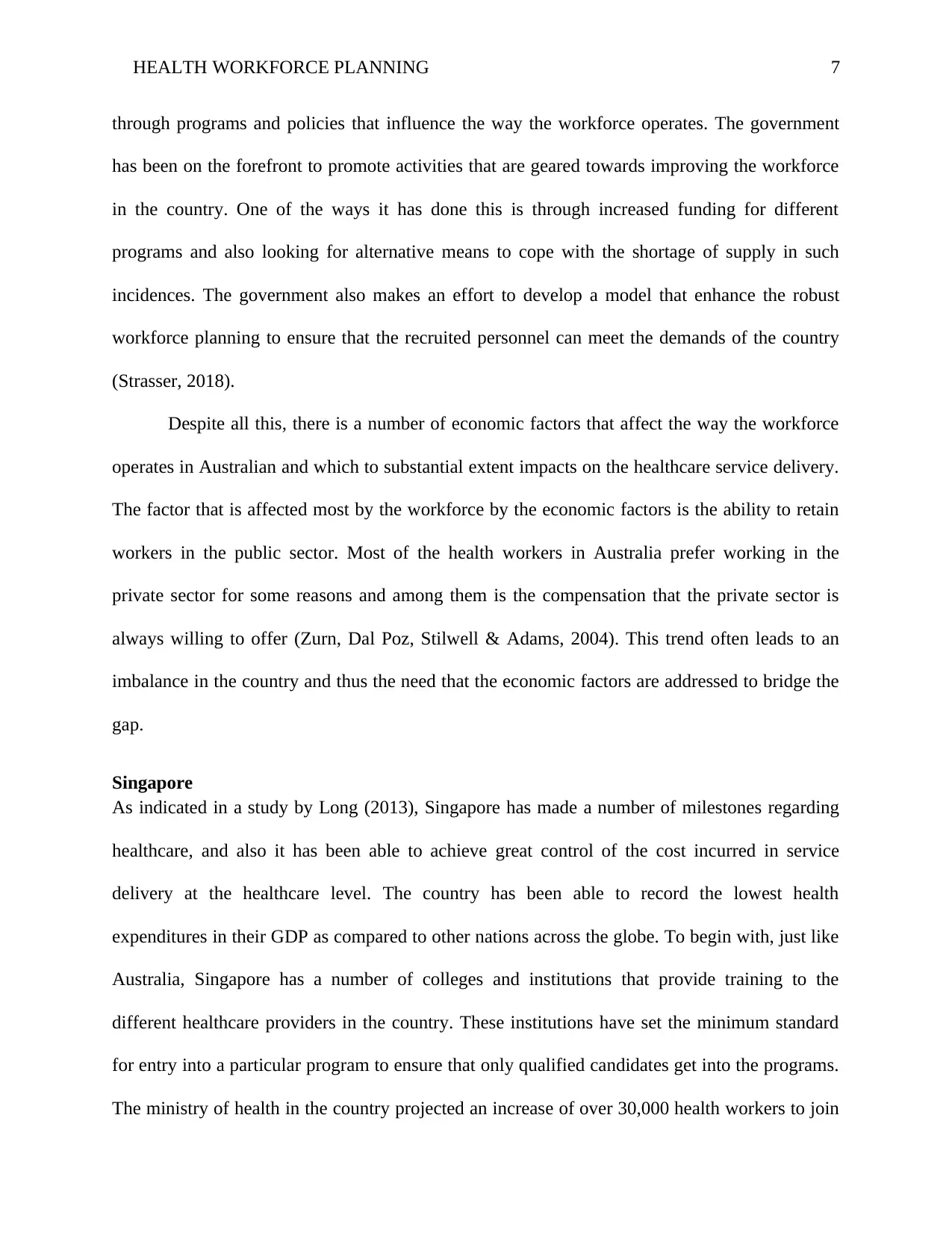
HEALTH WORKFORCE PLANNING 7
through programs and policies that influence the way the workforce operates. The government
has been on the forefront to promote activities that are geared towards improving the workforce
in the country. One of the ways it has done this is through increased funding for different
programs and also looking for alternative means to cope with the shortage of supply in such
incidences. The government also makes an effort to develop a model that enhance the robust
workforce planning to ensure that the recruited personnel can meet the demands of the country
(Strasser, 2018).
Despite all this, there is a number of economic factors that affect the way the workforce
operates in Australian and which to substantial extent impacts on the healthcare service delivery.
The factor that is affected most by the workforce by the economic factors is the ability to retain
workers in the public sector. Most of the health workers in Australia prefer working in the
private sector for some reasons and among them is the compensation that the private sector is
always willing to offer (Zurn, Dal Poz, Stilwell & Adams, 2004). This trend often leads to an
imbalance in the country and thus the need that the economic factors are addressed to bridge the
gap.
Singapore
As indicated in a study by Long (2013), Singapore has made a number of milestones regarding
healthcare, and also it has been able to achieve great control of the cost incurred in service
delivery at the healthcare level. The country has been able to record the lowest health
expenditures in their GDP as compared to other nations across the globe. To begin with, just like
Australia, Singapore has a number of colleges and institutions that provide training to the
different healthcare providers in the country. These institutions have set the minimum standard
for entry into a particular program to ensure that only qualified candidates get into the programs.
The ministry of health in the country projected an increase of over 30,000 health workers to join
through programs and policies that influence the way the workforce operates. The government
has been on the forefront to promote activities that are geared towards improving the workforce
in the country. One of the ways it has done this is through increased funding for different
programs and also looking for alternative means to cope with the shortage of supply in such
incidences. The government also makes an effort to develop a model that enhance the robust
workforce planning to ensure that the recruited personnel can meet the demands of the country
(Strasser, 2018).
Despite all this, there is a number of economic factors that affect the way the workforce
operates in Australian and which to substantial extent impacts on the healthcare service delivery.
The factor that is affected most by the workforce by the economic factors is the ability to retain
workers in the public sector. Most of the health workers in Australia prefer working in the
private sector for some reasons and among them is the compensation that the private sector is
always willing to offer (Zurn, Dal Poz, Stilwell & Adams, 2004). This trend often leads to an
imbalance in the country and thus the need that the economic factors are addressed to bridge the
gap.
Singapore
As indicated in a study by Long (2013), Singapore has made a number of milestones regarding
healthcare, and also it has been able to achieve great control of the cost incurred in service
delivery at the healthcare level. The country has been able to record the lowest health
expenditures in their GDP as compared to other nations across the globe. To begin with, just like
Australia, Singapore has a number of colleges and institutions that provide training to the
different healthcare providers in the country. These institutions have set the minimum standard
for entry into a particular program to ensure that only qualified candidates get into the programs.
The ministry of health in the country projected an increase of over 30,000 health workers to join
Paraphrase This Document
Need a fresh take? Get an instant paraphrase of this document with our AI Paraphraser
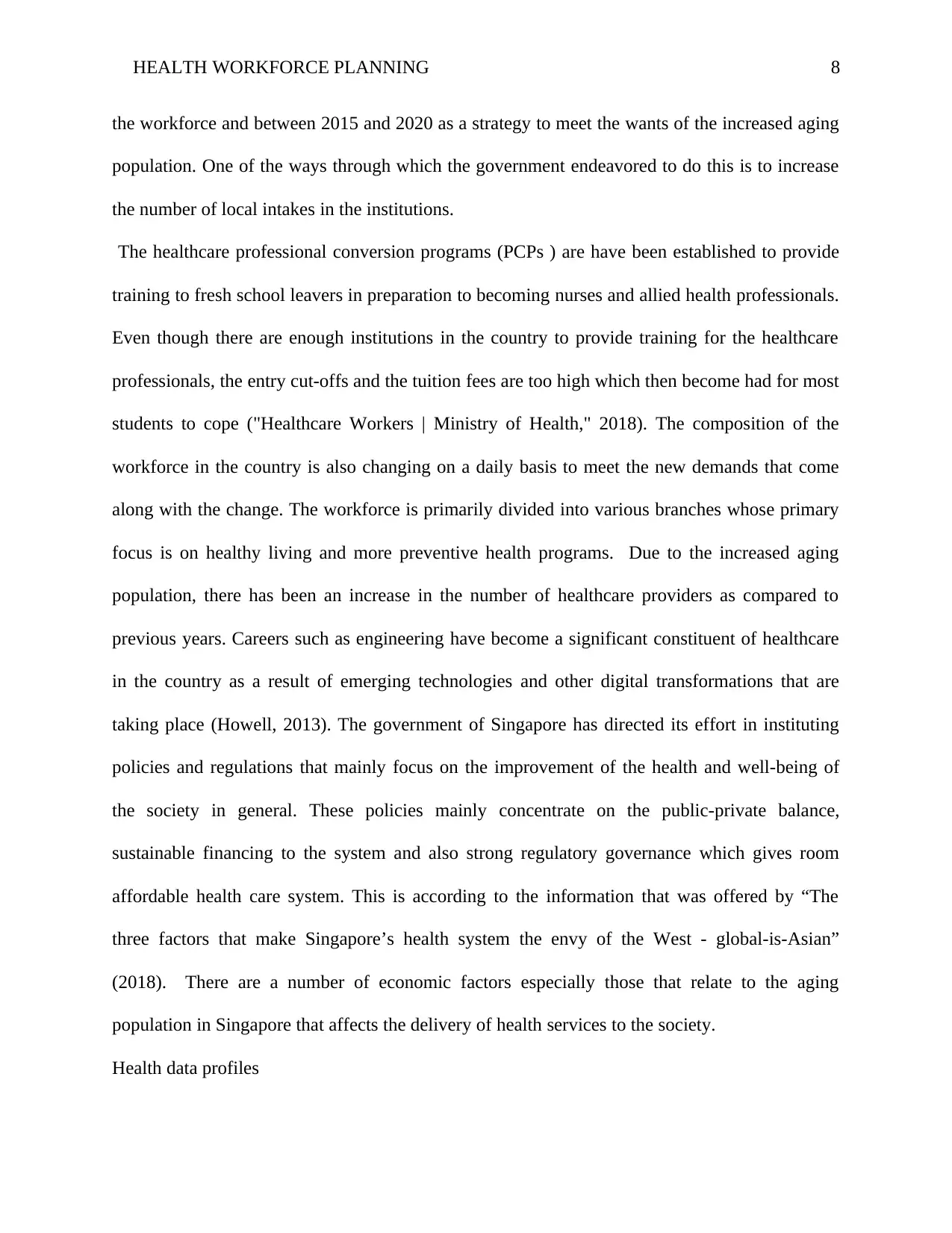
HEALTH WORKFORCE PLANNING 8
the workforce and between 2015 and 2020 as a strategy to meet the wants of the increased aging
population. One of the ways through which the government endeavored to do this is to increase
the number of local intakes in the institutions.
The healthcare professional conversion programs (PCPs ) are have been established to provide
training to fresh school leavers in preparation to becoming nurses and allied health professionals.
Even though there are enough institutions in the country to provide training for the healthcare
professionals, the entry cut-offs and the tuition fees are too high which then become had for most
students to cope ("Healthcare Workers | Ministry of Health," 2018). The composition of the
workforce in the country is also changing on a daily basis to meet the new demands that come
along with the change. The workforce is primarily divided into various branches whose primary
focus is on healthy living and more preventive health programs. Due to the increased aging
population, there has been an increase in the number of healthcare providers as compared to
previous years. Careers such as engineering have become a significant constituent of healthcare
in the country as a result of emerging technologies and other digital transformations that are
taking place (Howell, 2013). The government of Singapore has directed its effort in instituting
policies and regulations that mainly focus on the improvement of the health and well-being of
the society in general. These policies mainly concentrate on the public-private balance,
sustainable financing to the system and also strong regulatory governance which gives room
affordable health care system. This is according to the information that was offered by “The
three factors that make Singapore’s health system the envy of the West - global-is-Asian”
(2018). There are a number of economic factors especially those that relate to the aging
population in Singapore that affects the delivery of health services to the society.
Health data profiles
the workforce and between 2015 and 2020 as a strategy to meet the wants of the increased aging
population. One of the ways through which the government endeavored to do this is to increase
the number of local intakes in the institutions.
The healthcare professional conversion programs (PCPs ) are have been established to provide
training to fresh school leavers in preparation to becoming nurses and allied health professionals.
Even though there are enough institutions in the country to provide training for the healthcare
professionals, the entry cut-offs and the tuition fees are too high which then become had for most
students to cope ("Healthcare Workers | Ministry of Health," 2018). The composition of the
workforce in the country is also changing on a daily basis to meet the new demands that come
along with the change. The workforce is primarily divided into various branches whose primary
focus is on healthy living and more preventive health programs. Due to the increased aging
population, there has been an increase in the number of healthcare providers as compared to
previous years. Careers such as engineering have become a significant constituent of healthcare
in the country as a result of emerging technologies and other digital transformations that are
taking place (Howell, 2013). The government of Singapore has directed its effort in instituting
policies and regulations that mainly focus on the improvement of the health and well-being of
the society in general. These policies mainly concentrate on the public-private balance,
sustainable financing to the system and also strong regulatory governance which gives room
affordable health care system. This is according to the information that was offered by “The
three factors that make Singapore’s health system the envy of the West - global-is-Asian”
(2018). There are a number of economic factors especially those that relate to the aging
population in Singapore that affects the delivery of health services to the society.
Health data profiles
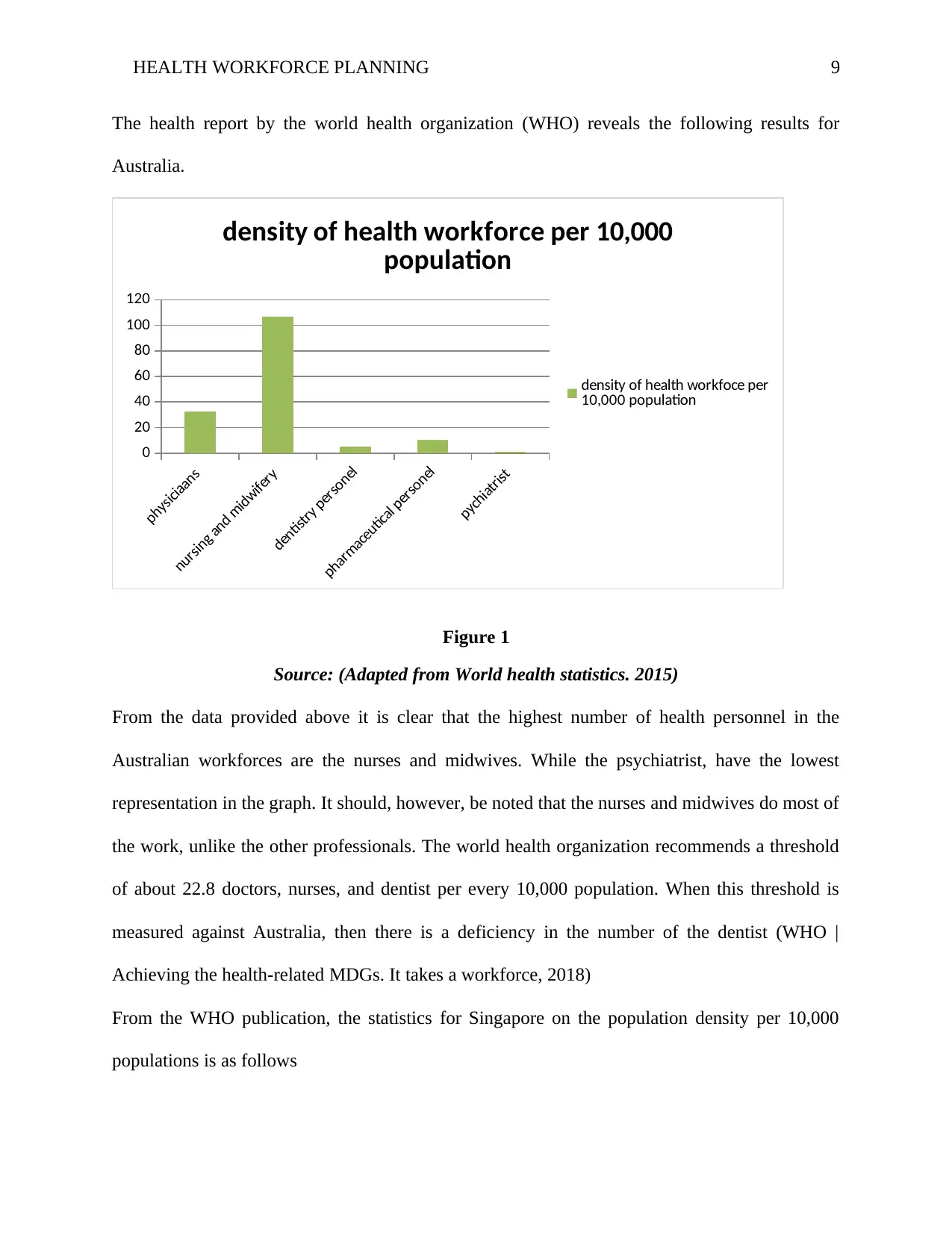
HEALTH WORKFORCE PLANNING 9
The health report by the world health organization (WHO) reveals the following results for
Australia.
physiciaans
nursing and midwifery
dentistry personel
pharmaceutical personel
pychiatrist
0
20
40
60
80
100
120
density of health workforce per 10,000
population
density of health workfoce per
10,000 population
Figure 1
Source: (Adapted from World health statistics. 2015)
From the data provided above it is clear that the highest number of health personnel in the
Australian workforces are the nurses and midwives. While the psychiatrist, have the lowest
representation in the graph. It should, however, be noted that the nurses and midwives do most of
the work, unlike the other professionals. The world health organization recommends a threshold
of about 22.8 doctors, nurses, and dentist per every 10,000 population. When this threshold is
measured against Australia, then there is a deficiency in the number of the dentist (WHO |
Achieving the health-related MDGs. It takes a workforce, 2018)
From the WHO publication, the statistics for Singapore on the population density per 10,000
populations is as follows
The health report by the world health organization (WHO) reveals the following results for
Australia.
physiciaans
nursing and midwifery
dentistry personel
pharmaceutical personel
pychiatrist
0
20
40
60
80
100
120
density of health workforce per 10,000
population
density of health workfoce per
10,000 population
Figure 1
Source: (Adapted from World health statistics. 2015)
From the data provided above it is clear that the highest number of health personnel in the
Australian workforces are the nurses and midwives. While the psychiatrist, have the lowest
representation in the graph. It should, however, be noted that the nurses and midwives do most of
the work, unlike the other professionals. The world health organization recommends a threshold
of about 22.8 doctors, nurses, and dentist per every 10,000 population. When this threshold is
measured against Australia, then there is a deficiency in the number of the dentist (WHO |
Achieving the health-related MDGs. It takes a workforce, 2018)
From the WHO publication, the statistics for Singapore on the population density per 10,000
populations is as follows
⊘ This is a preview!⊘
Do you want full access?
Subscribe today to unlock all pages.

Trusted by 1+ million students worldwide
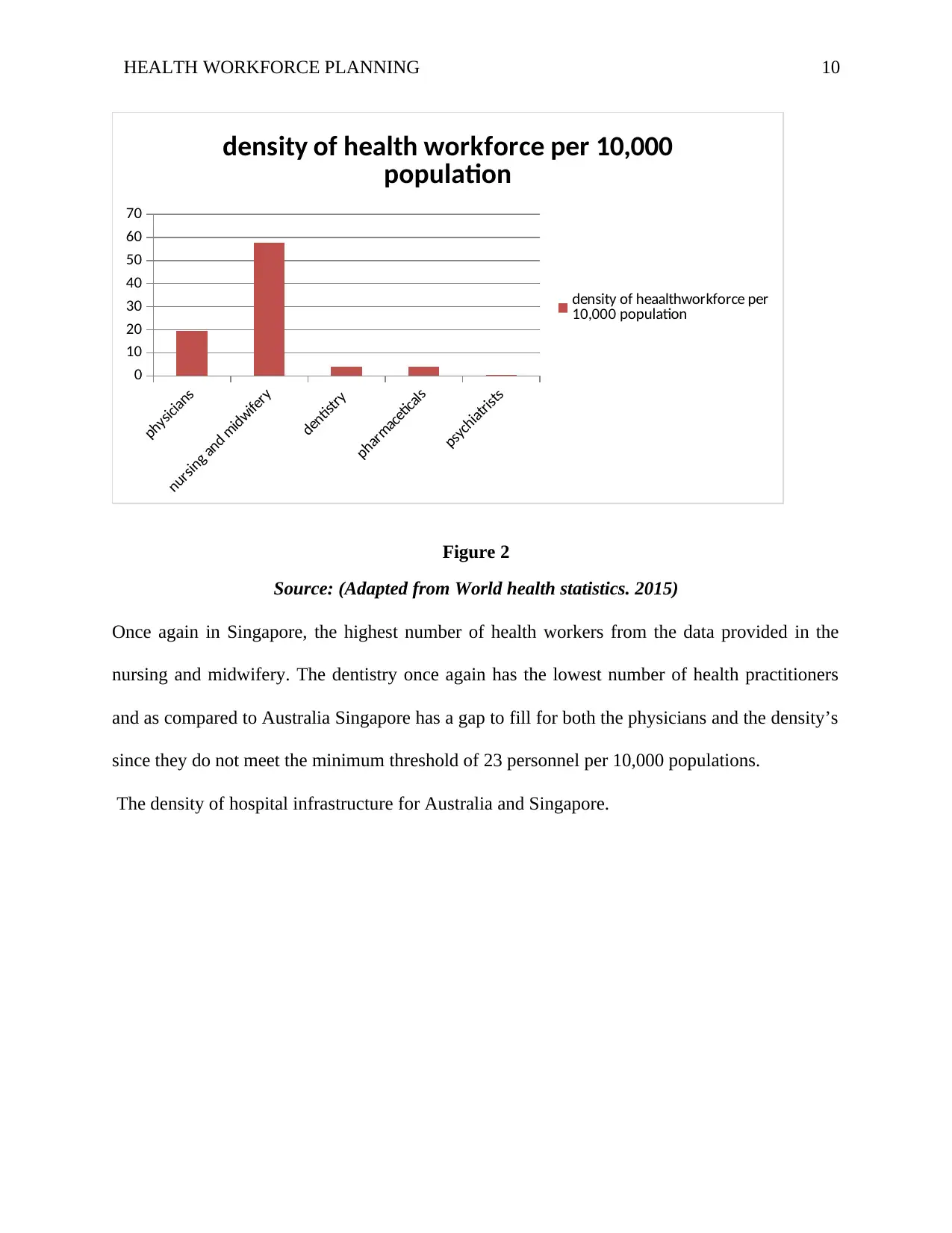
HEALTH WORKFORCE PLANNING 10
physicians
nursing and midwifery
dentistry
pharmaceticals
psychiatrists
0
10
20
30
40
50
60
70
density of health workforce per 10,000
population
density of heaalthworkforce per
10,000 population
Figure 2
Source: (Adapted from World health statistics. 2015)
Once again in Singapore, the highest number of health workers from the data provided in the
nursing and midwifery. The dentistry once again has the lowest number of health practitioners
and as compared to Australia Singapore has a gap to fill for both the physicians and the density’s
since they do not meet the minimum threshold of 23 personnel per 10,000 populations.
The density of hospital infrastructure for Australia and Singapore.
physicians
nursing and midwifery
dentistry
pharmaceticals
psychiatrists
0
10
20
30
40
50
60
70
density of health workforce per 10,000
population
density of heaalthworkforce per
10,000 population
Figure 2
Source: (Adapted from World health statistics. 2015)
Once again in Singapore, the highest number of health workers from the data provided in the
nursing and midwifery. The dentistry once again has the lowest number of health practitioners
and as compared to Australia Singapore has a gap to fill for both the physicians and the density’s
since they do not meet the minimum threshold of 23 personnel per 10,000 populations.
The density of hospital infrastructure for Australia and Singapore.
Paraphrase This Document
Need a fresh take? Get an instant paraphrase of this document with our AI Paraphraser
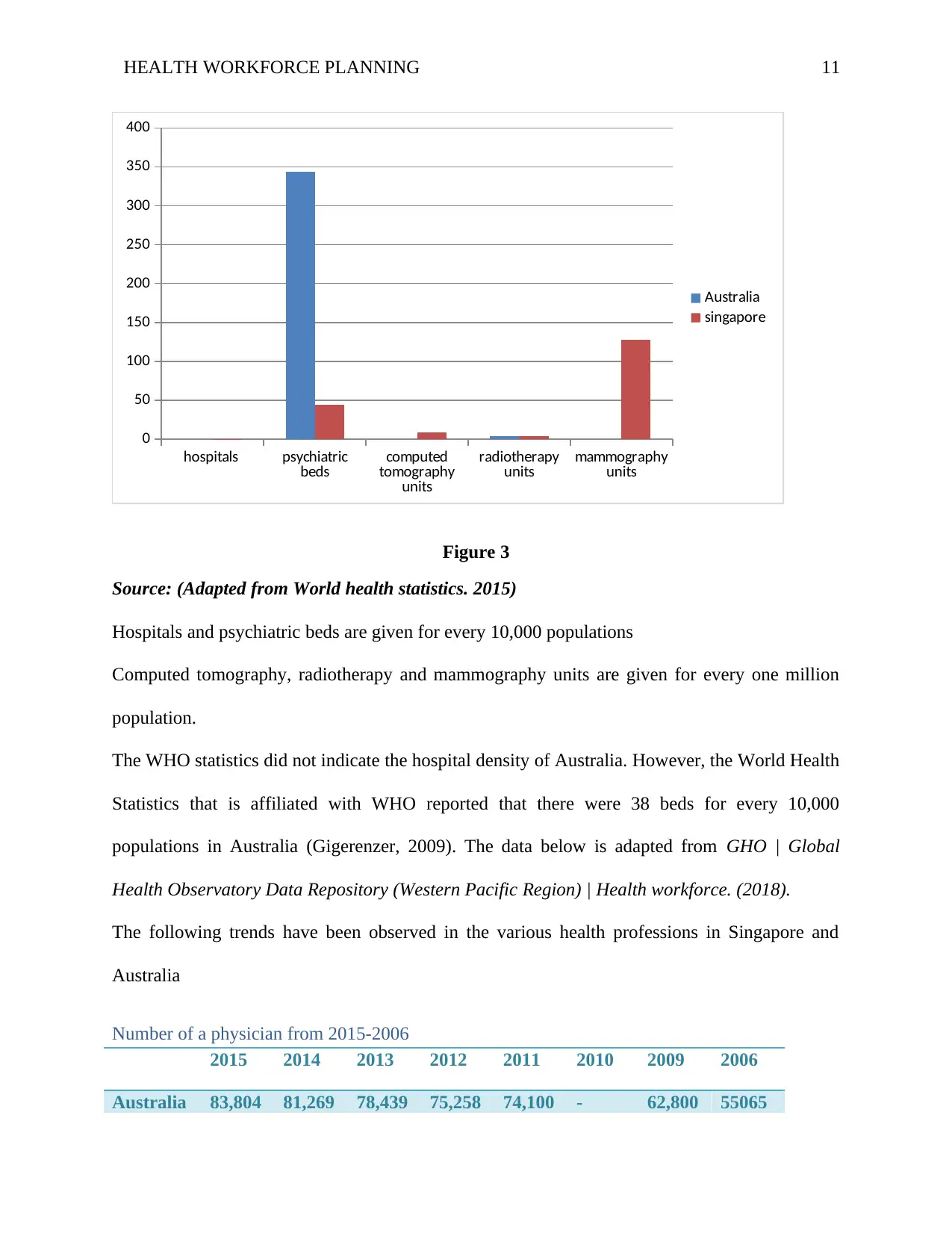
HEALTH WORKFORCE PLANNING 11
hospitals psychiatric
beds computed
tomography
units
radiotherapy
units mammography
units
0
50
100
150
200
250
300
350
400
Australia
singapore
Figure 3
Source: (Adapted from World health statistics. 2015)
Hospitals and psychiatric beds are given for every 10,000 populations
Computed tomography, radiotherapy and mammography units are given for every one million
population.
The WHO statistics did not indicate the hospital density of Australia. However, the World Health
Statistics that is affiliated with WHO reported that there were 38 beds for every 10,000
populations in Australia (Gigerenzer, 2009). The data below is adapted from GHO | Global
Health Observatory Data Repository (Western Pacific Region) | Health workforce. (2018).
The following trends have been observed in the various health professions in Singapore and
Australia
Number of a physician from 2015-2006
2015 2014 2013 2012 2011 2010 2009 2006
Australia 83,804 81,269 78,439 75,258 74,100 - 62,800 55065
hospitals psychiatric
beds computed
tomography
units
radiotherapy
units mammography
units
0
50
100
150
200
250
300
350
400
Australia
singapore
Figure 3
Source: (Adapted from World health statistics. 2015)
Hospitals and psychiatric beds are given for every 10,000 populations
Computed tomography, radiotherapy and mammography units are given for every one million
population.
The WHO statistics did not indicate the hospital density of Australia. However, the World Health
Statistics that is affiliated with WHO reported that there were 38 beds for every 10,000
populations in Australia (Gigerenzer, 2009). The data below is adapted from GHO | Global
Health Observatory Data Repository (Western Pacific Region) | Health workforce. (2018).
The following trends have been observed in the various health professions in Singapore and
Australia
Number of a physician from 2015-2006
2015 2014 2013 2012 2011 2010 2009 2006
Australia 83,804 81,269 78,439 75,258 74,100 - 62,800 55065
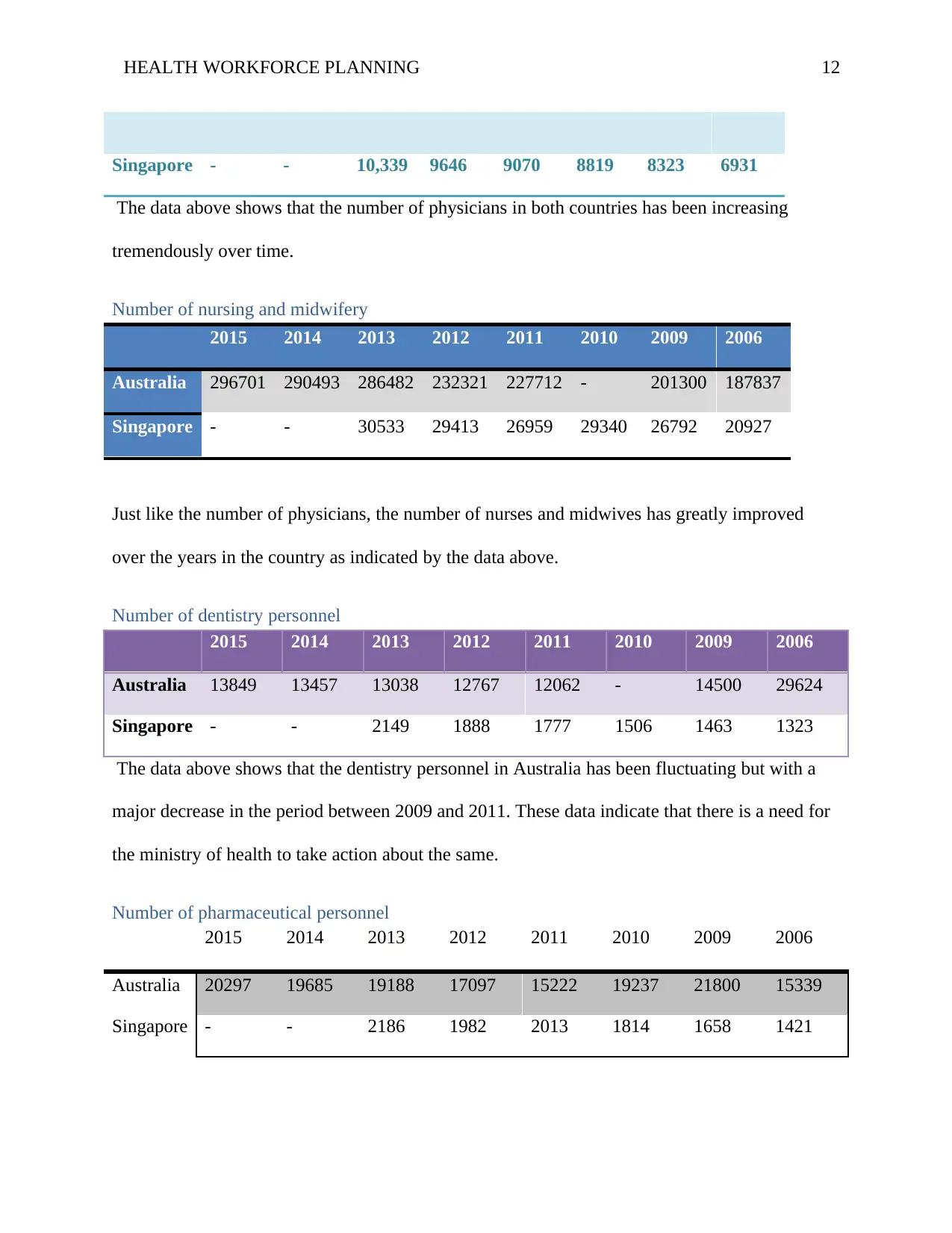
HEALTH WORKFORCE PLANNING 12
Singapore - - 10,339 9646 9070 8819 8323 6931
The data above shows that the number of physicians in both countries has been increasing
tremendously over time.
Number of nursing and midwifery
2015 2014 2013 2012 2011 2010 2009 2006
Australia 296701 290493 286482 232321 227712 - 201300 187837
Singapore - - 30533 29413 26959 29340 26792 20927
Just like the number of physicians, the number of nurses and midwives has greatly improved
over the years in the country as indicated by the data above.
Number of dentistry personnel
2015 2014 2013 2012 2011 2010 2009 2006
Australia 13849 13457 13038 12767 12062 - 14500 29624
Singapore - - 2149 1888 1777 1506 1463 1323
The data above shows that the dentistry personnel in Australia has been fluctuating but with a
major decrease in the period between 2009 and 2011. These data indicate that there is a need for
the ministry of health to take action about the same.
Number of pharmaceutical personnel
2015 2014 2013 2012 2011 2010 2009 2006
Australia 20297 19685 19188 17097 15222 19237 21800 15339
Singapore - - 2186 1982 2013 1814 1658 1421
Singapore - - 10,339 9646 9070 8819 8323 6931
The data above shows that the number of physicians in both countries has been increasing
tremendously over time.
Number of nursing and midwifery
2015 2014 2013 2012 2011 2010 2009 2006
Australia 296701 290493 286482 232321 227712 - 201300 187837
Singapore - - 30533 29413 26959 29340 26792 20927
Just like the number of physicians, the number of nurses and midwives has greatly improved
over the years in the country as indicated by the data above.
Number of dentistry personnel
2015 2014 2013 2012 2011 2010 2009 2006
Australia 13849 13457 13038 12767 12062 - 14500 29624
Singapore - - 2149 1888 1777 1506 1463 1323
The data above shows that the dentistry personnel in Australia has been fluctuating but with a
major decrease in the period between 2009 and 2011. These data indicate that there is a need for
the ministry of health to take action about the same.
Number of pharmaceutical personnel
2015 2014 2013 2012 2011 2010 2009 2006
Australia 20297 19685 19188 17097 15222 19237 21800 15339
Singapore - - 2186 1982 2013 1814 1658 1421
⊘ This is a preview!⊘
Do you want full access?
Subscribe today to unlock all pages.

Trusted by 1+ million students worldwide
1 out of 18
Related Documents
Your All-in-One AI-Powered Toolkit for Academic Success.
+13062052269
info@desklib.com
Available 24*7 on WhatsApp / Email
![[object Object]](/_next/static/media/star-bottom.7253800d.svg)
Unlock your academic potential
Copyright © 2020–2025 A2Z Services. All Rights Reserved. Developed and managed by ZUCOL.




